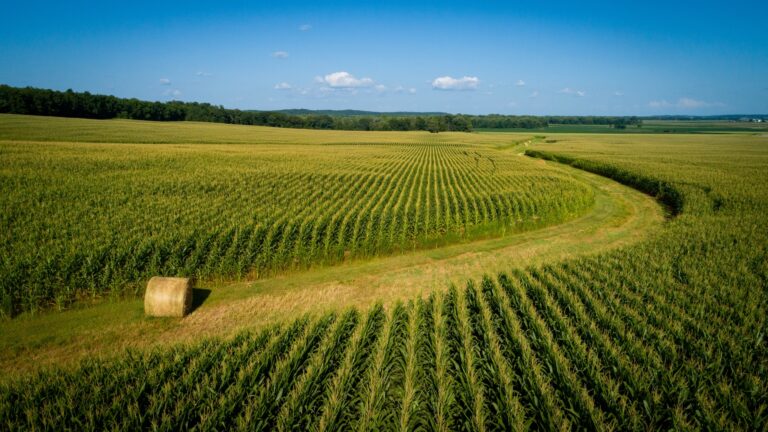2025 September Stewardship Advocate
What Iowa Corn Farmers Are Doing to Support Research on Nitrogen Use
Des Moines Register opinion piece authored by Jerod Flaherty (August 31, 2025).
Though the recent central Iowa ban on irrigating lawns has been lifted, there are still many questions about farmers’ use of nitrogen fertilizer. The use of nitrogen fertilizer is correlated with yield of corn. The higher the yield, the more nitrogen is consumed by a healthy corn plant. Corn yields continue to increase each year, meaning the crop requires more fertilizer from the soil. Yet, even with increased yields, farmers are applying less fertilizer per bushel of corn than ever before.
Can farmers do more to continue improving nitrogen utilization? I think we can, but it will take an investment in research to do so. That’s why in 2022, the Iowa Corn Promotion Board established a Sustainability Innovation Lab. This lab is not a building or facility but rather a commitment of resources to implementing better sustainability practices.
We can reduce our reliance on synthetic nitrogen fertilizer by developing innovations and improved practices for growing corn. Improving yield is one option; growing more bushels of corn per unit of land is the most efficient use of resources.
Iowa State University is working on research to improve its fertilizer application recommendations for growing corn. This effort is funded by the Iowa Corn Promotion Board, several commodity organizations and the Iowa Department of Agriculture and Land Stewardship.
Other practices that improve water quality are being developed. The Iowa Corn Promotion Board is funding research projects at Iowa State University and the US Department of Agriculture’s Agricultural Research Service on soil microbes that supply organic nitrogen from the soil to the corn crop. We have funded many years of research to improve the genetics of the corn crop to be more efficient in utilizing nitrogen fertilizer. However, strict regulations for transgenic crops limit the ability to commercialize new technologies.
Iowa is blessed with extremely fertile soils, making it the best place on the planet for growing corn. Iowa’s farmers cherish the land they work and are continually implementing new farming practices to improve nitrogen utilization. We know there is still work to be done, which is why the corn promotion board is dedicated to investing in research that will likely lead to the next breakthrough for growing corn.
Jerod Flaherty has been farming in Clarke County for over 20 years, raising corn, soybeans, forage crops, and a cow herd while utilizing cover crops and rotational grazing. He currently serves as the Iowa Corn Promotion Board Director for District 8 and as Chair of the Animal Agriculture & Environment Committee, in addition to participating on the Clarke County FSA Committee and Clarke County Cattlemen.
Latest Information
New Study: Unrestricted Sales of E15 Would Fuel the Economy
NCGA Honors Three Winners Driving Innovation in Consider Corn Challenge V
Saturated buffers: Proven practice with new surprises – Agriculture and the Environment
Secretary Naig Announces Streamside Buffer Pilot Project Targeting Priority Watersheds
Secretary Naig to Present the Gieselman Family with the Wergin Good Farm Neighbor Award
History of Corn Yields – Decision Innovation Solutions
Guide-to-Seed-Treatment-Stewarship-2025
Iowa NRCS Sets Oct. 10 Cutoff for Conservation Program Applications

Farmer to Farmer: Chad Harms
Chad Harms has been farming near Hartley, Iowa, in O’Brien County for more than 30 years. After graduating from the University of South Dakota, he returned home to farm with his father and uncle. Today, Chad and his wife Jill farm with two of his uncles, raising corn and soybeans in a rotation although they may plant more corn if market conditions favor corn.
Their farm goals are to remain profitable while focusing on long-term sustainability by improving soil health and boosting yields through sound management. He says, “I am a third-generation farmer, and while my father wasn’t a full-time farmer, I’ve always valued carrying on the family tradition. Passing the farm to the next generation is important to me. Both of our children have shown an interest in agriculture, one works as an agronomist, and the other is a senior at Iowa State University majoring in Ag Engineering.”
As to their operation’s management system, Chad says they consider soil type, yield history and other metrics to guide planting populations, fertilizer applications and crop protection needs. He says, “For fertility, we rely primarily on hog manure, chicken litter and composted cattle manure, along with some nitrogen applied with our spring pre-herbicide program on corn. About one-third of our soybean acres are no-till, while the rest are managed with minimum tillage. All of our corn acres are also minimum till. We’re always testing new practices. For example, in 2025, we trialed a couple of biologicals and seed treatments, and we look forward to seeing results at harvest.”
Chad serves as a Director on the Iowa Corn Promotion Board representing District 1. Regarding his participation in Iowa Corn, Chad says, “I feel fortunate to be involved with Iowa Corn where I’ve had the opportunity to learn about new technology, policy and legislation while also helping ensure that farmers’ voices and needs are represented, both today and for the future.”
Upcoming Events:
October 8, November 12 and December 10 – Iowa Nutrient Research Center webinar series Fall 2025 Water Quality Seminar: Regional Collaborative Research | Iowa Nutrient Research Center
Throughout October – ISU Extension Calendar of Events
November 10 – 2025 Farming for the Future Conference
